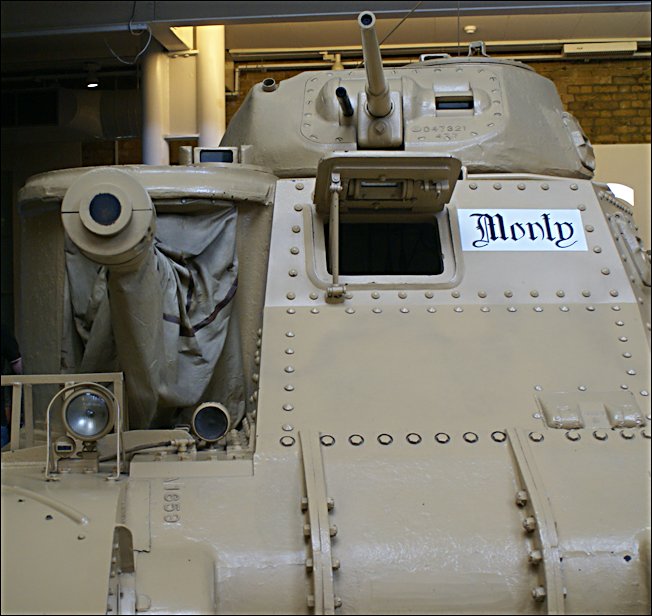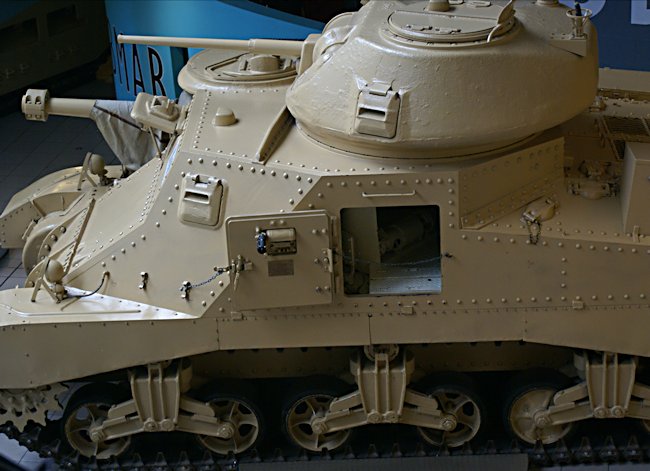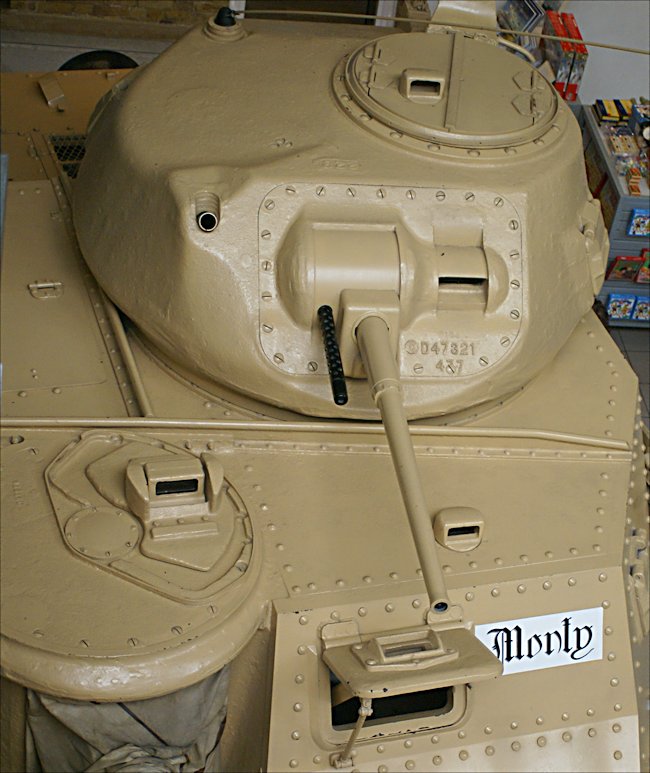Monty's M3A5 Grant II Tank used at El Alamein
Field Marshal Bernard Montgomery used this British M3A5 Grant Medium tank during the WW2 battle of El Alamein. This tank used to be on display at the Imperial War Museum London up until 2014. It is now on display at the Imperial War Museum Duxford.

Field Marshal Montgomery's M3A5 Grant II Medium Tank
He continued to use it in North Africa until Rommel and the Germans were defeated. It went with him during the invasion of Sicily in July 1943 and later during the invasion of the Italian mainland. The main difference with this M3A5 Grant II variant is that it had a better twin diesel engine and an American Lee style riveted smaller turret but without the Cupola. Between August 1941 and December 1942 6,258 M3 Tanks were built including over 500 of the M3A5 variants. Field Marshal Montgomery used this tank as a forward command vehicle. The turret 37mm gun was removed and it was replaced with a dummy barrel to enable extra communications equipment to be fitted.

Side view of Field Marshal Montgomery's M3A5 Grant II Medium Tank
Is this a M3A3 or M3A5 Medium Tank?
The M3A3 Medium tank had a welded hull. The M3A5 Medium tank had a riveted hull like this one. This is a M3A5 Medium tank. The confusion sometimes arises because the chassis/build plate inside this tank says it is a M3A3 Medium tank which is wrong. The error occurred because the US Ordnance changed the reporting designation from M3A3 for any diesel GM 4046 x 2 M3 to M3A3 for welded construction M3s with GM twin 4046 and M3A5 for riveted construction M3 diesels (GM 4046 twin) no-one told the manufacturer Pullman in time and the plates were stamped M3A3.
Churchill did not like using the US system of naming tanks. He got confused especially when there was a M3 light tank and an M3 Medium tank. He issued an instruction that imported US built tanks in British service will be given the names of US Generals. The M3A5 was known as the Grant Mk II medium tank by the British and Commonwealth armies.
There was a new tank in the desert – The M3 Lee / M3 Grant
After an abortive Afrika Korps raid by Rommel, the British General Cunningham launched ‘Operation Crusader’ as a counter offensive on 18th November with 750 tanks, which included 280 of the newly supplied US made Stuart light tank. They were supported by 600 artillery guns.
Rommel used two Panzer Divisions and his Italian allies to mass and deliver concentrated blows against dispersed British and Commonwealth troops and armoured brigades in a series of bloody battles. At one point two British armoured brigades were reduced from 350 to just fifty tanks in four days.
General Cunningham wanted to withdraw but was replaced by General Neil Ritchie. Rommel took the chance and made a dash for the Egyptian frontier to cut off the British line of retreat. This caused temporary panic in Cairo. Rommel over reached his line of supply and had also lost a lot of units. He was down to only forty German and thirty Italian battle worthy tanks. He had to retreat westwards again back to his original start point. He had lost 195 tanks.

Top view of the turret on Field Marshal Montgomery's M3A5 Grant II Medium Tank. Notice that the turret hatch is flat. The US M3 Lee tank version has a raised cupola housing an additional machine gun.
After a resupply of the long promised upgraded Panzer tanks he launched yet another attack. Within two weeks he had pushed 400 miles eastwards towards the fortified line covering Tobruk where the two opposing sides remained in stalemate for four months. Both sides built up their strength for the next move. By the end of May the Axis had 637 tanks verse 994 Allied tanks, but the allies were now receiving a new vastly stronger tank.
The US made M3 Grant and M3 Lee was the first effective tank the British 8th Army Desert Rats were able to field against the Italian Army and German Afrika Korps. It had lots of design faults but it caused some consternation when it first appeared on the North African battlefield in1942. For its time it had good frontal armour. Feldwebel Herman Eckardt recalled that the 8th Panzer Regiment lost eighty-six panzers the first time they came up against the M3 Grant. They nicknamed it the ‘pilot’ because they needed to get as close as 300 metres to penetrate its armour. Most Italian and German tanks at that time period only had 30mm frontal armour with 10mm at the side. The 50mm frontal armour of the new M3 Grant was a shock to the enemy.
Eckardt’s tank was knocked out by a Grant, which he and his fellows found a considerable technical shock. This ran counter to the diet of invincibility of the German Armour and military machine propaganda newsreels they were being shown following the 1940 invasion of France.
Eckardt remembered thinking that for the first time the war might not be going as well as he had been told. They had not been told about the qualities of this new tank. What else had they not been told.
The M3 grant tank enabled the Tommie’s, Ozzies and Kiwis to at last be able to fire a 75mm HE round, which enabled them to emulate previous German tank success by suppressing anti-tank guns at long range. It was a demanding six man tank to command and fight. British Tank M3 Grant tank commander Sergeant Fred Dale of the 3rd Royal Tank Regiment RTR recalled, "The only thing wrong was the height. It was always hard to hide behind any ridge without showing the turret. Anyway the crews were overjoyed to be able to fire a large weight shell at the panzer tanks." An American maintenance sergeant said, "It looked like a damned cathedral coming down the road." The M3 Grant was an interim solution while the M4 successor was developed.
Where can I find other preserved American M3 Lee Tanks?
- Ordnance Museum USA
- Academia Militar de Agulhas Negras Brazil
- Museu Militar Conde de Linhares Brazil
- Praça do Ex-Combatente Brazil
- Escola de Material Bélico Brazil
- Parque Regional de Manutenção da 1ª Região Militar Brazil
- RAAC Tank Museum Australia
- Yad la-Shiryon, Latrun Israel
- Canadian War Museum Canada
- Tank Museum in Kubinka Russia
- Military Vehicle Technology Foundation USA
- Virginia Museum of Military Vehicles USA
World War Two books

